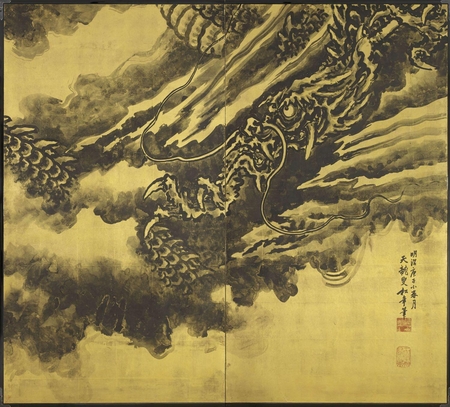Product Description
7117 A two-fold paper screen painted in ink on a gold ground with a ryū (dragon) amongst clouds.
Signed: Meiji kanoe-ne koharu-zuki, Tenryu-sō Shōnen-hitsu (Painted Shonen, the old man Tenryū, in the 10th month of the year of Kanoe-ne, the Meiji Period)
by Dragon in the Sky
Seals:
Upper: Tenryū-sō Shōnen (Shōnen of an old man Tenryū)
Lower: Ikkyo kyūmangyoku (Lit. Single Lift, Nine-million jades)
Japan 20th century Meiji period *November 1900
Dimensions: H. 67½” x W. 74½” (171cm x 189cm)
Suzuki Shōnen (1849-1918) Gō (art name): Chikuson.
Shōnen was born and lived in Kyoto. He was the son and pupil of Suzuki Hyakunen (1825-1891) a leading painter of the Shijō school who established his own style of painting without adhering to any of the established styles such as the Shijo-Maruyama, Nanga or Kano schools. Due to his father’s position, and his own talent, which was apparent from an early age, Shōnen was able to study at the imperial palace and also at Kyoto Prefectural School of Painting. From 1881 to 1888 he taught Chinese painting at the Northern division of the Kyoto Art Academy, taking the position vacated by Kōno Bairei (1844-1895). He specialised in landscapes and kachōga (bird and flower painting) as well as traditional and Buddhist subjects. Shōnen never worked from preliminary sketches (shita-e) but painted quickly and directly, in a bold, individual style. He painted the famous dragons in the main building of the Tenryū-ji and several landscape screens in the Ryōgen-in of Daitoku-ji. In his later years his work had a great influence on the Kyoto art world, his best known pupils being Shōshū Saitō (b.1870), Kimura Kōnen (b.1877) and Uemura Shōen (1875 –1949).
The Eastern dragon is not the gruesome monster of medieval imagination, but the genius of strength and goodness. He represents the spirit of change, and therefore life itself. Hidden in the caverns of inaccessible mountains, or coiled in the unfathomed depths of the sea, he awaits the time when he slowly rouses himself into activity. He unfolds himself in the storm clouds and washes his mane in the blackness of the seething whirlpools. His claws form forks of lightning, his scales begin to glisten in the bark of rain-swept pine trees. His voice is heard in the hurricane, which scattering the withered leaves of the forest quickens a new spring.
The Shuo Wen dictionary states that the dragon is the chief of the scaly reptiles. It wields the power of transformation and the gift of rendering itself visible or invisible at will. In the spring it ascends to the skies and in the autumn hides in the watery depths of the ocean. It covers itself with mud in the autumnal equinox, and emerges in the spring, thus announcing by its awakening the return of nature’s energies.
In the traditional cosmology of China, the dragon is one of the Four Sacred Creatures, representing the east, the spring and water. It is thus the complement of the tiger which represents autumn, the western direction, the wind and the colour white. This pairing in Japanese art is known as ryukozu. The interaction of the two – the play of wind and water is thought vital for creating the nurturing weather that makes soil fertile and crops prosper.
Dragons are a traditional subject-matter of the kanga or Chinese style of paintings. They were often painted on large format surfaces such as ceilings and walls.
Japan took from China the habit of associating ryū (dragons) with the imperial institution, Buddhism and the virtue of vigilance. By the late 7th century dragons were popular as painted images in Buddhist temples while later they assumed secular applications in paintings and other arts.
Depending on the context dragons are teamed with a variety of motifs, however the most common design pairings are with stylised cloud or wave motifs, reflecting the animal’s association with both the sky and the oceans.
Works by the artist can be found in the collections of: Ashmolean Museum, Oxford; British Museum, London; Daitoku-ji (Ryōgen-in), Kyoto; Honolulu Academy of Arts, Hawaii; Sanzen-in, Kyoto; Tenryū-ji, Kyoto; Victoria and Albert Museum, London.








